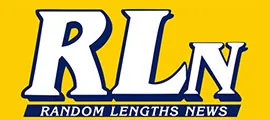Master of Satire and Irony
By Andrea Serna, Arts and Culture Writer
When sculptor, artist and printmaker William “Bill” Crutchfield died April 20, the San Pedro art community lost a brilliant member.
Bill is survived by his wife Barbara, with whom he shared his life for more than 50 years. As a career partner, she assisted him with the construction of his sculptures and documented his profession. As his wife, she provided sustenance.
“I made the spaghetti that kept him going,” Barbara said.
Bill was born in rural Indiana. His childhood was spent immersed in nature. He grew up on a farm where a favorite pastime was lying on the ground observing the light passing through the negative space between the leaves of the trees. As a young boy Bill became interested in art through a life drawing course in Indiana. The process of discovering the skill and technique of drawing bone and muscle sparked an interest in anatomy.
“The best book I ever read was an anatomy book” Bill once said.
Through this practice he experienced a kind of enlightenment.
“I can’t bring myself to kill a spider,” he once said during an interview with Random Lengths News. “I know they have legs and a body just like me.”
The artist was in love with drawing, which he said he did every day.
In 1956, he earned a bachelor’s degree in fine arts from the Herron School of Art at Indiana University in Indianapolis. In 1960, he earned a master’s degree in fine arts from Tulane University in New Orleans. From 1960 to 1962, he studied at the Hochschule fuer bildende Kuenste in Hamburg, Germany. He taught foundation studies and advanced drawing at the Herron School of Art, in Indianapolis, from 1962 to 1965. From 1965 to 1967, he was chairman of Foundation Studies at the Minneapolis College of Art.
His works are in collections nationally from the Museum of Modern Art in New York to the Los Angeles County Museum of Art and internationally from the Tate Modern, London, to the National Gallery of Australia and the Singapore Art Museum.
Bill’s interest in the relationship between man and machine was particularly suited to the Los Angeles County Museum of Art’s significant but controversial Art and Technology exhibition in 1971. Crutchfield produced its screen-printed poster and several illustrations for the catalog.
In spite of the finely detailed precision of his drawings, it was his sculptures that displayed his talent for engineering. The artist spent many years of his career working for NASA. One piece, titled “Countdown,” is a homage to the space program that occupied his life during this period. Bronze numbers literally countdown to “blast off” in this piece, in a reflection of a rocket’s preparation to send man towards the exploration of space.
Numbers and letters were also a theme. In an irrational, illogical formation the letter M is transformed into W in Man, Woman. In his sculpture “Fly,” the bronze sculpture presents the observer with a puzzle. “Fly” is read front and back as the letters morph in opposition.
He and his wife, Barbara, settled in their studio in San Pedro in 1974, producing drawings, paintings, hand lithography prints, screenprints, digital prints and sculpture.
A satirical commentary on humanity often resided beneath Bill’s whimsical subject matter and exquisite draftsmanship. The artist used a variety of media, sculpture, painting and prints to harness his imagination.
“In a painting you are looking at layers and layers of paint and varnish, drawing is the hand moving,” artist Ron Linden described. “I believe Bill thought with a pencil.”
During his interview with Random Lengths Bill also said he frequently places pen on paper and allows it to move, as he watches images emerge.
The action was fascinating to him. After laying down the detailed lines, he highlighted with fine touches of color to pull out the images he found on the page. The result is a cross between M.C. Escher and Google Doodles.
“Every line is meant to be there,” Bill told Random Lengths News. “Each component in the drawing is important.”
But there was much more to his imagination. Bill never lost his boyhood fascinations with things mechanical. Trains, planes and ships serve as vessels of transport for his imagination. Trains also took on a fantasy aspect for him. Locomotives chug across the page; wheels churn at a fantastic pace; steam engines spew massive chunky smoke as it goes.
One of Crutchfield’s last exhibitions was at Ray Carofano’s Gallery 478 in his hometown of San Pedro.
“He is one of the most literate artists that I have come across,” Carofano said. “He was a student of all of his subjects.”
Crutchfield was a master of lithography. As a professor, one of Bill’s star students was Los Angeles lithographer Kenneth Tyler, who went on to found the influential print house Gemini G.E.L.
“The emphasis on drawing was a natural fit for printmaking,” Ron said.
William worked both at Gemini and Tamarind, beginning in 1960 where he completed his series Air Land and Sea, a suite of 13 lithographs.
“Crutchfield’s real merit is his being a social artist who is genuinely visually inventive, and a visual artist whose comments have quite a bit to say—sneakily, quietly, (humorously), profoundly –about the errors of our ways,” art critic Peter Plagens wrote.
His wife said the loss of his presence in the art community is profoundly felt. His reaction to his own loss might be reflective of his art and impact.
“Bill would laugh,” Barbara said. “He would say, ‘It doesn’t matter because it’s all a myth anyway.’”



